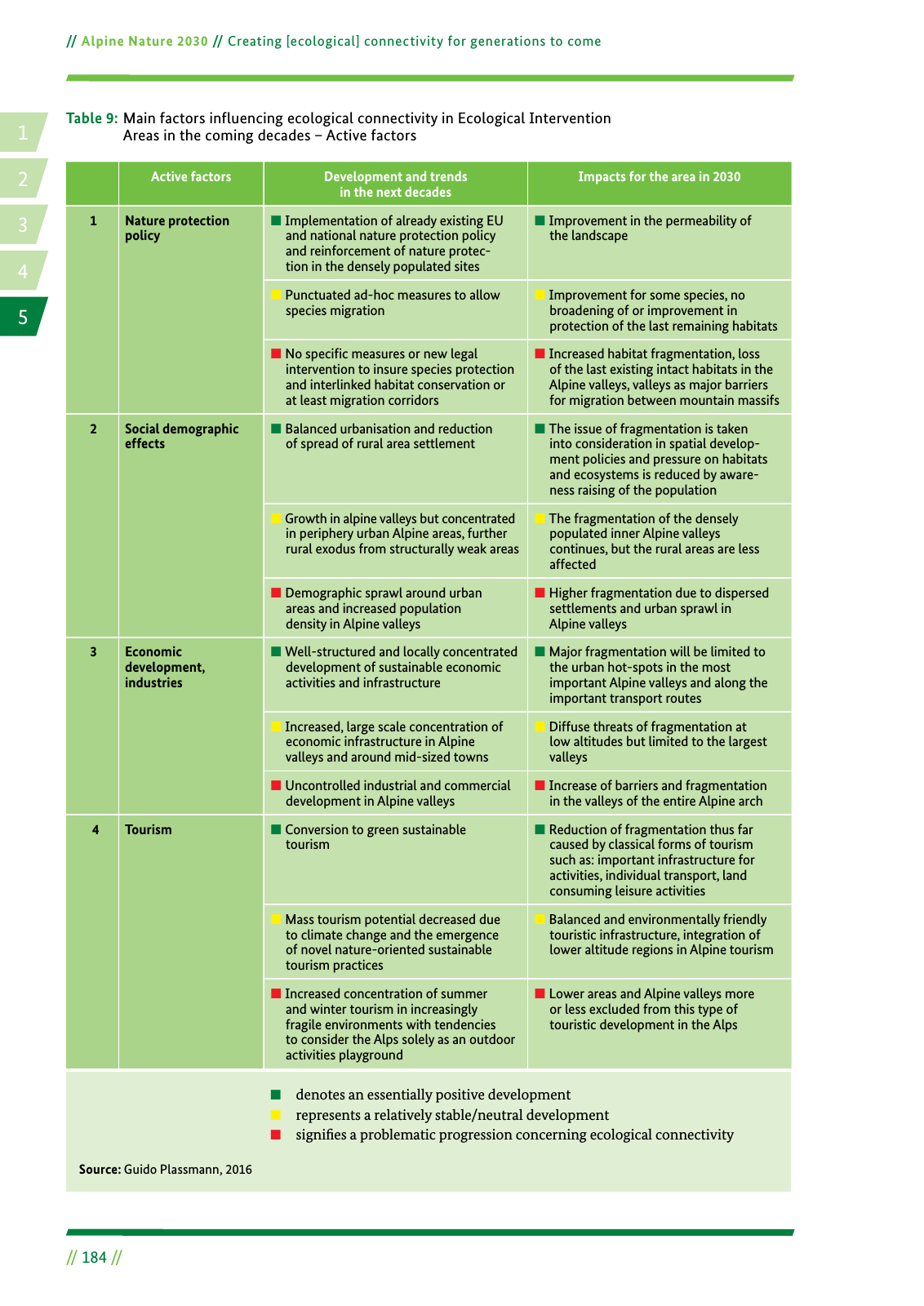14 2 5 3 Alpine Nature 2030 Creating ecological connectivity for generations to come 184 Table 9 Main factors influencing ecological connectivity in Ecological Intervention Areas in the coming decades Active factors Active factors Development and trends in the next decades Impacts for the area in 2030 1 Nature protection policy ó Implementation of already existing EU and national nature protection policy and reinforcement of nature protec tion in the densely populated sites ó Improvement in the permeability of the landscape ó Punctuated ad hoc measures to allow species migration ó Improvement for some species no broadening of or improvement in protection of the last remaining habitats ó No speci c measures or new legal intervention to insure species protection and interlinked habitat conservation or at least migration corridors ó Increased habitat fragmentation loss of the last existing intact habitats in the Alpine valleys valleys as major barriers for migration between mountain massifs 2 Social demographic effects ó Balanced urbanisation and reduction of spread of rural area settlement ó The issue of fragmentation is taken into consideration in spatial develop ment policies and pressure on habitats and ecosystems is reduced by aware ness raising of the population ó Growth in alpine valleys but concentrated in periphery urban Alpine areas further rural exodus from structurally weak areas ó The fragmentation of the densely populated inner Alpine valleys continues but the rural areas are less affected ó Demographic sprawl around urban areas and increased population density in Alpine valleys ó Higher fragmentation due to dispersed settlements and urban sprawl in Alpine valleys 3 Economic development industries ó Well structured and locally concentrated development of sustainable economic activities and infrastructure ó Major fragmentation will be limited to the urban hot spots in the most important Alpine valleys and along the important transport routes ó Increased large scale concentration of economic infrastructure in Alpine valleys and around mid sized towns ó Diffuse threats of fragmentation at low altitudes but limited to the largest valleys ó Uncontrolled industrial and commercial development in Alpine valleys ó Increase of barriers and fragmentation in the valleys of the entire Alpine arch 4 Tourism ó Conversion to green sustainable tourism ó Reduction of fragmentation thus far caused by classical forms of tourism such as important infrastructure for activities individual transport land consuming leisure activities ó Mass tourism potential decreased due to climate change and the emergence of novel nature oriented sustainable tourism practices ó Balanced and environmentally friendly touristic infrastructure integration of lower altitude regions in Alpine tourism ó Increased concentration of summer and winter tourism in increasingly fragile environments with tendencies to consider the Alps solely as an outdoor activities playground ó Lower areas and Alpine valleys more or less excluded from this type of touristic development in the Alps ó denotes an essentially positive development ó represents a relatively stable neutral development ó signi es a problematic progression concerning ecological connectivity Source Guido Plassmann 2016

Hinweis: Dies ist eine maschinenlesbare No-Flash Ansicht.
Klicken Sie hier um zur Online-Version zu gelangen.
Klicken Sie hier um zur Online-Version zu gelangen.